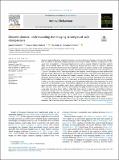Files in this item
Discrete choices : understanding the foraging strategies of wild chimpanzees
Item metadata
| dc.contributor.author | Villioth, Jakob | |
| dc.contributor.author | Zuberbühler, Klaus | |
| dc.contributor.author | Newton-Fisher, Nicholas E. | |
| dc.date.accessioned | 2023-05-18T14:30:06Z | |
| dc.date.available | 2023-05-18T14:30:06Z | |
| dc.date.issued | 2023-06-01 | |
| dc.identifier | 283383281 | |
| dc.identifier | 1fb3cbe0-f7ba-44d8-80f4-e1fe66027af1 | |
| dc.identifier | 85159559625 | |
| dc.identifier.citation | Villioth , J , Zuberbühler , K & Newton-Fisher , N E 2023 , ' Discrete choices : understanding the foraging strategies of wild chimpanzees ' , Animal Behaviour , vol. 200 , 22-00324 , pp. 209-219 . https://doi.org/10.1016/j.anbehav.2023.04.003 | en |
| dc.identifier.issn | 0003-3472 | |
| dc.identifier.other | ORCID: /0000-0001-8378-088X/work/135454593 | |
| dc.identifier.uri | https://hdl.handle.net/10023/27646 | |
| dc.description | Funding: This work was supported by a University of Kent 50th Anniversary Scholarship, and a Cotutelle de thèse grant from swissuniversities to J.V. | en |
| dc.description.abstract | Optimal foraging theory has guided much of the research on foraging behaviour in the past five decades, with the notion of optimality deeply embedded in most models today. However, assuming that all foragers strive to maximize a certain predefined currency, such as amount of food per unit time, restricts what can be learned about the factors influencing foraging decisions. Here we applied a different approach: the discrete-choice model, which does not assume an optimal strategy as the starting point, but instead examines foraging decisions directly, modelling interpatch movements as the consequence of a choice of destination from a limited set of options. We analysed a set of foraging decisions by both adult male and female chimpanzees, Pan troglodytes, from two habituated communities in the Budongo forest, Uganda, to investigate the influence of foraging variables including food patch characteristics and interpatch distance on patch choice, with a view to identifying the strategy underlying these decisions. Despite differences in habitat between communities, we found that foraging strategies were remarkably similar across both communities and sexes, with chimpanzees exhibiting a clear preference for closer and novel (not previously visited) food patches. Individuals of both communities frequently chose to forage on food patches providing young leaves, highlighting the importance of this food type in their diet. Contrary to expectation, patch size did not predict foraging decisions, except for adult males of one community that chose larger patches, while both sexes aimed to minimize travel distance between consecutive patches. This study provides the first direct evidence that chimpanzees consider travel distance and whether they have recently visited a patch when choosing between potential foraging sites and demonstrates that new insights can be gained (even in a well-studied system) from integrating several important variables describing feeding ecology into a coherent model of patch choice. | |
| dc.format.extent | 11 | |
| dc.format.extent | 546600 | |
| dc.language.iso | eng | |
| dc.relation.ispartof | Animal Behaviour | en |
| dc.subject | Discrete-choice model | en |
| dc.subject | Foraging | en |
| dc.subject | Pan troglodytes | en |
| dc.subject | Patch size | en |
| dc.subject | Sex difference | en |
| dc.subject | QL Zoology | en |
| dc.subject | DAS | en |
| dc.subject | MCC | en |
| dc.subject.lcc | QL | en |
| dc.title | Discrete choices : understanding the foraging strategies of wild chimpanzees | en |
| dc.type | Journal article | en |
| dc.contributor.institution | University of St Andrews. Institute of Behavioural and Neural Sciences | en |
| dc.contributor.institution | University of St Andrews. Centre for Social Learning & Cognitive Evolution | en |
| dc.contributor.institution | University of St Andrews. School of Psychology and Neuroscience | en |
| dc.identifier.doi | https://doi.org/10.1016/j.anbehav.2023.04.003 | |
| dc.description.status | Peer reviewed | en |
This item appears in the following Collection(s)
Items in the St Andrews Research Repository are protected by copyright, with all rights reserved, unless otherwise indicated.

